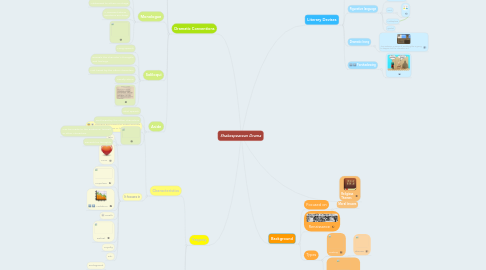
1. Tragedy
1.1. Characteristics
1.1.1. Humans are meant to suffer and die because of their flaws or fate.
1.1.2. It focuses in
1.1.2.1. fate
1.1.2.2. Love
1.1.2.3. Impulses
1.1.2.4. Ambition
1.1.2.5. Death
1.1.2.6. Defeat
1.1.2.7. Loyalty
1.1.2.8. Etc.
1.2. Types of Characters
1.2.1. Tragic hero
1.2.1.1. Protagonist
1.2.1.2. Will die because of his tragic flaws
1.2.1.3. Usually high rank in society
1.2.2. Antagonist
1.2.2.1. Opposing force
1.2.2.2. Helps create the conflict
1.2.2.3. Contributes to the hero´s downfall
1.2.3. Foil
1.2.3.1. His personality contrasts with the rest of the characters.
1.2.3.2. Creates a "COMIC RELIEF"
1.3. Plot
1.3.1. conflicts of the antagonist lead to the downfall
1.3.2. Downfall = CATASTROPHE
1.3.2.1. Main caracter
2. Dramatic Conventions
2.1. Divided in
2.1.1. Acts
2.1.1.1. Scenes
2.1.1.2. .
2.2. Written in
2.2.1. Dialogue
2.2.1.1. Stage directions
2.2.2. Blank verse
2.2.2.1. IAMBIC pentameter
2.2.2.2. Rhyme
2.3. Monologue
2.3.1. Long speach
2.3.2. Addressed to others on stage
2.3.3. A moment where emotions are deep
2.3.4. .
2.4. Soliloqui
2.4.1. Long speach
2.4.2. Reveals the character´s thoughts and feelings.
2.4.3. Not heard by the other characters
2.4.4. Usually alone
2.4.5. .
2.5. Aside
2.5.1. Shot speach
2.5.2. Not heard by the other characters
2.5.3. .
2.5.3.1. Can be made to the audience, himself or other characters.
2.5.3.2. Reveals his thoughts
3. Religious Themes
4. Background
4.1. Focused on
4.1.1. Moral lessons
4.2. Renaissance
4.3. Types
4.3.1. History
4.3.1.1. Stories
4.3.2. Tragedy & Comedy
5. Literary Devises
5.1. Allusions
5.1.1. Indirect reference to mythological or biblical characters
5.1.2. .
5.2. Figurative language
5.2.1. Personification
5.2.2. Simili
5.2.2.1. .
5.2.3. Methaphore
5.2.4. Symbol
5.3. Dramatic Irony
5.3.1. The audience is aware of somthing tha is going to happen but the character isn't
5.4. Forshadowing
5.4.1. .
